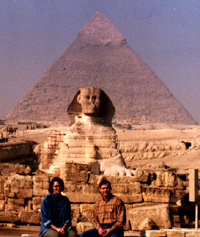 Photo.
Photo. The Great
Pyramid of Cheops in Giza, Egypt (illustration photo from Travel Explorations).
Dr. Zahi Hawass, a leading archaeologist and National Geographic
Explorer-in-Residence and a team of Egyptian scientists has removed the mummy
from its sarcophagus for the first time in more than 25 years.
The scientific team has refined the technique of using the CT scanner on
Egypt's most high-profile mummy. Their intention was to use state of the art CT
scan technology to solve the mystery surrounding King Tut's death.
A mummy is the body of a person (or an animal) that has been preserved after
death. Mummies have been found in many places throughout the world, from
Greenland to China to the Andes Mountains of South America. The Egyptian ones
are the most famous. There have been used several methods for preserving dead
people through history. For more information see below.
The CT scan displayed loose bones inside King Tut's skull, severed ribs and a
fractured left leg with a missing kneecap. The big questions were: was he
murdered? Or was he hurt in battle? Does the newly discovered broken leg offer
clues to his death?
King Tut's Final Secrets attempts to solve the mystery. Dr. Hawas is now
sure that King Tut`s was not murdered. He actually died from comlications due to
broken bones.
Stein Morten Lund, 15 May 2005
Additional information
Read about Dr. Hawass and
the famous pyramids, including information about sites in Giza, conservation and
management of the Giza plateau, the excavation of the the Golden Mummies, and
much more.
Click on the link: www.guardians.net/hawass
Read about great mysteries from ancient Egypt on the website Guardian's
Egypt: www.guardians.net
Fore more information, click on www.NationalGeographic.com
